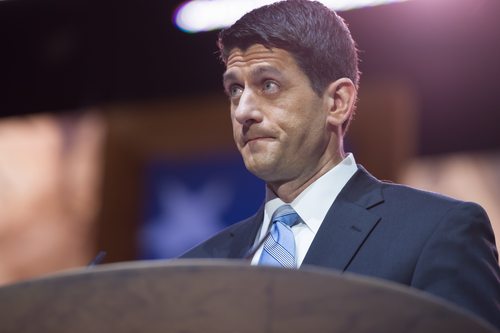
April 22, 2014;Forbes
Forbes economics writer Mark Hendrickson writes that Dick Morris, the former political consultant to Bill Clinton who became a political advisor to Republicans, advised his new party allies in the House of Representatives not to pass the budget developed a month ago by Rep. Paul Ryan (R-WI) because it would guarantee a Republican loss of the House to Nancy Pelosi and the Democrats in November. The fatal flaw, he said, was Ryan’s focus on slowing the growth of the federal budget and reforming Social Security, Medicare, and Medicaid.
It is difficult to figure out what may be motivating Morris, especially since the chances of the Ryan budget becoming the nation’s budget are just about nonexistent. But some elements of the House Budget Committee’s product may survive the congressional interplay, especially as politicians of both parties may not be as opposed to some of Ryan’s budgetary themes as their rhetoric may appear.
If aspects of the Ryan budget have legs, nonprofits should know what’s in the details for the issues they are concerned about. Culling through the budget reveals these nonprofit-relevant tidbits:
Sign up for our free newsletters
Subscribe to NPQ's newsletters to have our top stories delivered directly to your inbox.
By signing up, you agree to our privacy policy and terms of use, and to receive messages from NPQ and our partners.
- Amazingly, the Ryan budget increases military spending and makes massive cuts in the tax rates of millionaires. If Ryan is interested in balancing the budget—and couches changes such as increasing the eligibility age for Medicare as components of that—it makes no sense that the budget would let millionaires pay even less tax than they do and would fund the nation’s already bloated Pentagon apparatus.
- Sometimes the national aggregates of increases and decreases are hard to make real, but Ellie Hill, a Montana state representative (who we wrote about in 2012 because of her endorsement by Robert Egger’s CForward) boiled the human dimensions down to Montana-specific terms:
“Here’s what the GOP’s ‘Paul Ryan’ budget would mean for the state of Montana…10,952 seniors would pay more for medicine by bringing back the prescription drug donut hole; 1,780 college students wouldn’t receive Pell Grants; 236 domestic violence victims would lose access to the STOP Violence Against Women Program; 530 children would lose access to Head Start…But hey, 485 millionaires would get an $87,000 tax break.”
Expanding on Hill’s point, Jonathan Weisman writing for the New York Times noted that under the Ryan budget, “domestic programs would be reduced to the lowest levels since modern government accounting.” Partly, Ryan would achieve that by big cuts in food stamps, in Medicaid, and the total repeal of the Affordable Care Act. Reversing support for expanded Medicaid and eliminating the ACA would be strange, as though Republicans in the 1940s and 1950s decided to campaign to wipe out Social Security or in the 1980s and 1990s to eliminate Medicare.
- On Medicare, the Ryan budget actually makes changes that would change this single-payer system into something more complex, into a “premium support” system in which seniors could use federal money—think “vouchers”—to buy private insurance rather than relying on government-paid care. There is no question that there are problems with health care provision under Medicare, with many doctors not accepting Medicare patients, but converting it from the guarantee of government-paid coverage to the complexity of what private insurers will and won’t cover is a step in the wrong direction.
- To his credit, Ryan is one of the few politicians of either party willing to talk about poverty instead of simply repeating the mantra of the middle class, but his budget proposal represents a step backwards for poor people. Earlier in March, he issued a report, “The War on Poverty: 50 Years Later,” which took aim at what he said were the “nearly 100 programs at the federal level that are meant to help, but they have actually created a poverty trap.” But his overhaul is really a huge cut —$4.3 trillion in nondefense discretionary spending over ten years, with $3 trillion coming from critically important programs aimed at helping poor and working class Americans.
A meat-axe is an overhaul of sorts, but not the kind of overhaul that some had expected. Robert Woodson, the founder of the Center for Neighborhood Enterprise and the advisor to Ryan on poverty issues, responded to David Weigel of Slate that he believes—and one would guess Ryan knows this as well—that the Affordable Care Act is not going to be repealed. Although he indicated that any real overhaul of poverty programs would “have to wait till the election is over to do something serious,” Woodson plans to bring his allies this year together to present “specific, concrete anti-poverty proposals.” It isn’t clear how programs to help the poor get fixed by getting eviscerated.
Slashing Medicaid, reversing Medicaid expansions, and eliminating all of the Affordable Care Act are actually among the most devastating parts of the Ryan budget for the poor. Remember what drives working people into poverty as much as anything: More than mortgage payments, more than credit card bills, medical bills are the top cause of personal bankruptcies in the U.S. The sad result of the Ryan budget is that it would drive more people into poverty and gut many of the federal government’s social safety net supports to help low-income people survive and move back up the socio-economic status ladder. That’s the unfortunate message of the House Budget Committee’s political document.—Rick Cohen












